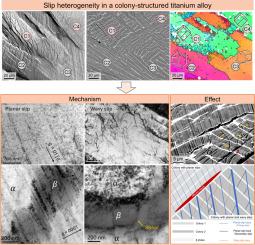Slip heterogeneity in a colony-structured titanium alloy: Planar versus wavy slip traces
IF 12.8
1区 材料科学
Q1 ENGINEERING, MECHANICAL
引用次数: 0
Abstract
Titanium (Ti) alloys with colony microstructures, including many near-α and α + β Ti alloys, are widely used in aerospace components. Although the characteristics of the colony microstructures have been extensively studied, the localized deformation behavior of individual colonies has been less reported. This study investigates the slip behavior of α colonies in a near-α Ti-6.5Al-2Mo-Zr-V alloy through surface slip trace analysis, revealing two distinct deformation modes: (i) homogeneous slips, characterized by dense, uniform, and straight planar slip lines; and (ii) heterogeneous slips, featuring wavy and planar slip traces with varying intensities. The wavy slip traces result from <a>-type screw dislocation cross-slips between basal, prismatic, and pyramidal planes, wherein the screw dislocations are primarily emitted from the stressed α/β interfaces at the colony boundaries. These stress concentrations at α/β interfaces arise from the mismatch of elastic modulus (ΔE > ∼5 GPa) and low geometrical compatibility (m' < ∼0.5) between adjacent colonies. All the planar slip traces are aligned with basal or prismatic planes, but the slip intensity - reflecting a degree of slip localization - varies significantly, and an easy slip transfer across an α/β interface promotes slip delocalization. Pyramidal-I <c+a>-type dislocations are also observed and enhance the slip heterogeneity. These findings provide critical insights into deformation heterogeneity in colony-structured titanium alloys, inspiring new pathways for microstructural design to enhance their mechanical performance for a wide range of applications.

群体结构钛合金的滑移不均匀性:平面与波浪形滑移轨迹
具有集落组织的钛(Ti)合金,包括许多近α和α + β Ti合金,广泛应用于航空航天部件。尽管人们对蚁群结构的特征进行了广泛的研究,但对单个蚁群的局部变形行为报道较少。通过对近α α Ti-6.5Al-2Mo-Zr-V合金表面滑移痕迹的分析,研究了α菌落的滑移行为,揭示了两种不同的变形模式:(i)均匀的平面滑移,其特征是密集、均匀和直的滑移线;(ii)非均质滑移,具有不同强度的波状轨迹和平面滑移。波状滑移轨迹是由基面、棱柱面和锥体面之间的<;a>;型螺位错交叉滑移引起的,其中螺位错主要来自群体边界处的应力α/β界面。这些α/β界面上的应力集中是由相邻菌落之间弹性模量(ΔE > ~ 5 GPa)的不匹配和低几何相容性(m' < ~ 0.5)引起的。所有的平面滑移轨迹都与基面或棱柱面对齐,但滑移强度(反映滑移局部化程度)变化显著,并且易于通过α/β界面传递滑移促进了滑移的非局部化。还观察到i <;c+a>;型位错,并增强了滑移不均匀性。这些发现为揭示群体组织钛合金的变形不均匀性提供了重要的见解,为微结构设计提供了新的途径,以提高力学性能。
本文章由计算机程序翻译,如有差异,请以英文原文为准。
求助全文
约1分钟内获得全文
求助全文
来源期刊

International Journal of Plasticity
工程技术-材料科学:综合
CiteScore
15.30
自引率
26.50%
发文量
256
审稿时长
46 days
期刊介绍:
International Journal of Plasticity aims to present original research encompassing all facets of plastic deformation, damage, and fracture behavior in both isotropic and anisotropic solids. This includes exploring the thermodynamics of plasticity and fracture, continuum theory, and macroscopic as well as microscopic phenomena.
Topics of interest span the plastic behavior of single crystals and polycrystalline metals, ceramics, rocks, soils, composites, nanocrystalline and microelectronics materials, shape memory alloys, ferroelectric ceramics, thin films, and polymers. Additionally, the journal covers plasticity aspects of failure and fracture mechanics. Contributions involving significant experimental, numerical, or theoretical advancements that enhance the understanding of the plastic behavior of solids are particularly valued. Papers addressing the modeling of finite nonlinear elastic deformation, bearing similarities to the modeling of plastic deformation, are also welcomed.
 求助内容:
求助内容: 应助结果提醒方式:
应助结果提醒方式:


